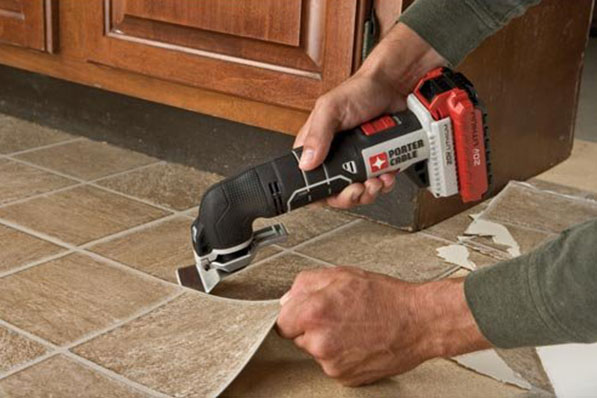
The absolute cornucopia of oscillating tool blades makes multi-tools the most versatile machines on the market. Crucial for the trade pro and enthusiastic DIYers, the multitude of attachments permit you to chop, cut, degrout, and plane.
However, the vast range of these tool heads can be overwhelming — even for the experienced contractor. Furthermore, it’s crucial that you utilize the ideal accessory for your current project to ensure the most impressive results.
That’s why it was important for me to create this article — to empower you with sufficient multi tool blade knowledge to ensure you complete your jobs safely and with rewarding results.
So, sit back, grab a cup of coffee, and join me on a journey through the different types of oscillating tool blades.
Are Oscillating Multi Tool Blades Universal?
Remember the heady days of the late 1970s and early 1980s? If you’re too young, let me fill you in.
Stick with me on this.
At this time, there was no Netflix or Hulu — if you wanted to watch a movie at home you needed to rent a videocassette. These were available in a multitude of different formats, the most popular two being Betamax (made by Sony) and VHS (from JVC). And, while both were excellent systems, they were not cross-compatible.
Eventually, VHS won the battle and became the standard home video method. Historians will tell you this was due to VHS’s longer recording time and greater durability, but in truth — like all things in life — it came down to sex.
The prudish Sony company wouldn’t allow pornography movie creators to put fruity content on their holier-than-thou Betamax format. The liberal JVC with its VHS cassettes couldn’t care less, so producers of ‘blue’ films flooded the market with sexy TV time on this system. No one wanted a video machine that couldn’t play porn, so Betamax lost the battle.
The story is similar with multitools — although without the interesting sex angle.
After the power tool meisters Fein invented the first oscillator in 1967, competitors jumped onto the bandwagon and created their own versions. Five years later, there were around 100 different multitool manufacturers with an equal number of alternative accessory fitting systems.
However, Fein’s friendly competitor Bosch adopted its attachment format. This meant that the two major players in DIY and trade tools now had a common system — so third-party manufacturers began to create accessories for these brands and forgot about the rest.
With competitor machines being virtually unsupported, DIYers and contractors switched to Bosch and Fein models. So, losing sales and money, these alternative manufacturers gave in and too switched to the German system — making it universal. Ironically, in 2016, Fein and Bosch created a completely new accessory fitting type, known as Starlock.
Today, nearly all attachments and oscillating tools are cross-compatible — whether corded or cordless. Those few with novel and weird designs usually include a universal accessory — permitting the use of standard blades, sanders, and cutters.
Do Oscillating Multitools Come With Blades and Accessories?
No, so it’s a valuable consideration when purchasing your multi-tool.
Some heavyweight manufacturers attempt to make their machines appear more reasonably priced by omitting blades and attachments — such as the DeWalt DCS356B.
Sure, if you know you’re making a tool-only purchase, this isn’t an issue. However, if you’re unaware that your shiny new tool is going to arrive sans accessories, you may become rapidly disappointed during unboxing as you discover you can’t do anything with your multitool apart from making it vibrate. You could always give it to the wife I suppose.
Admittedly, you can purchase comprehensive multi tool blade sets — but you need to consider this additional cost on top of the price of your machine.
Furthermore, also look at how many attachments are included with your oscillating unit. Some machines, such as the DIY-focused Black+Decker BD200MTB, arrive with just one wood/metal blade and a sanding plate. Other models, like the impressive DeWalt DWE315K, include a substantial 29-piece kit.
And, a quick word of warning.
Always check what type of extras are promised with your multitool — not just the volume. Many unscrupulous retailers advertise a ridiculously large number of accessories — making the unit appear excellent value. However, in reality, these are nothing more than a trade pack of budget-end sanding sheets — useful if you’re planning on hours of wood smoothing, pointless if you want a multitool to cut pipes.
Is Fitting Multi Tool Attachments Easy?
Yes! You don’t need a degree in engineering to switch accessories — although it’s important to check how the attachments are fitted.
There are two formats — tooled and tool-free. The tooled version (like the Makita MT01Z) requires a hex key to secure the blade, sander, or cutter in place. Tool-free versions permit head exchange at the press of a button.
Undoubtedly, the tool-free version (such as the Bosch GOP40-30B) is more rapid, and eliminates the risk of losing the tightening wrench. That said, they can be a little harder on your wallet.
The Best Oscillating Tool Blades
As the multi-tool accessory range is remarkably expansive, it’s impossible to explain every single type, format, and classification. However, I have included below the most common designs for typical trade and DIY applications.
Segmented Cutting Blade
Known by pros simply as a ‘seg’ — so use this term if you want to look like a seasoned oscillating machine user — the segmented cutting blade is a semicircular oscillating tool attachment that incorporates teeth around its rounded edge. Designed for making lengthy linear cuts as well as cutting and trimming close to material edges in hard-to-access areas — these accessories can tackle plastics, timber, and non-ferrous metals. Typical home and trade applications for these oscillating tool metal cutting blades include removing damaged bathroom tiles, shortening plumbing pipes, and resizing floor panels and laminates.
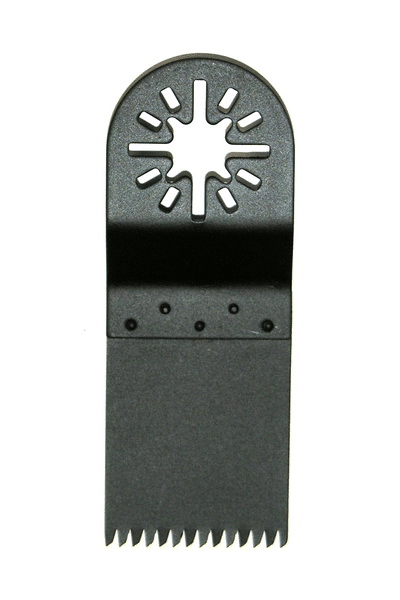
Plunge Cut Blade – Артём В., CC BY-SA 4.0, via Wikimedia Commons
Plunge Cut Blades
From all the numerous multi tool blades available, it’s perhaps the plunge cutter that’s most synonymous with oscillating machines. Long, flat, and offset from the vertical, they are typically shown attached to multitools in marketing material — an accessory that can access areas unreachable by traditional reciprocating or handheld saws. Its primary function is to penetrate into materials away from project edges — for example, when cutting recesses in drywall for electrical sockets or removing worktop sections to accommodate a hand basin. As the name suggests, these blades literally ‘dive’ into your target material — negating the requirement for pre-drilling to make access holes. Furthermore, their generous length and angled design mean you can effortlessly access and address confined space areas — such as trimming door bases and resizing baseboards while in-situ. Usually, these accessories focus on timbers and plastics, although there are some carbide-tipped varieties available for use on metals.
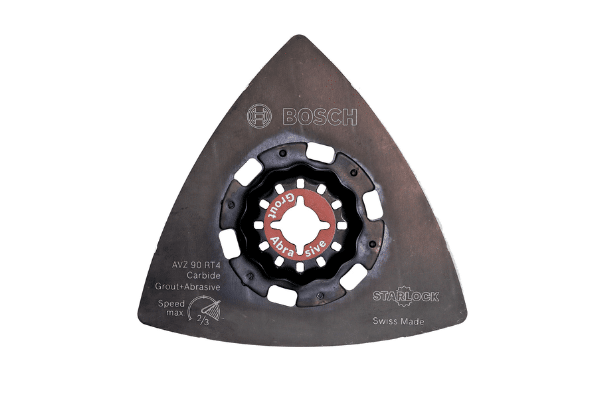
Sanding Base Plate – Ralf Pfeifer, CC BY-SA 4.0, via Wikimedia Commons
Sanding Base Plate
One of the best multi-tool attachments that isn’t cutting focused. The sanding plate accommodates a multitude of different grit and grade abrasive pads — its triangular design permitting you to address challenging corners and fine trim moldings. Depending on the disposable pads you choose, you can sand and smooth varnish, paint, bare wood, and plaster. However, take my advice — always go for the traditional 3.125-inch plate size. This is the industry standard, meaning you can effortlessly obtain replacement sanding sheets from a plethora of third-party suppliers. Some cheeky — or you could say profiteering — manufacturers include unusually dimensioned sanding accessories with their oscillating tools. Thus meaning you can only purchase these novel-sized pads from them. Sneaky guys.
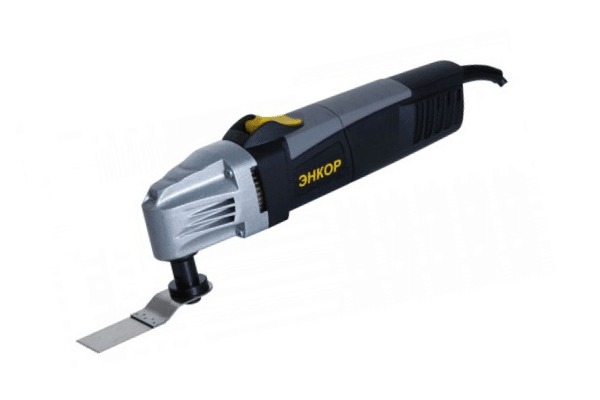
Multitool With Plunge Blade – Артём В., CC BY-SA 4.0, via Wikimedia Commons
Carbide or Diamond Oscillating Multi Tool Blades
The mother-of-all multitool blades — crucial when you’re tackling the most stubborn of materials. Admittedly, they’re significantly harder on the wallet than standard cutters, which is why they’re only available from third-party suppliers and not included with oscillating tool purchases. However, these blades — incorporating plunge and segmented formats — deliver the cleanest of cuts on metals, tiles, and porcelains. A worthwhile investment if your projects frequently require you to address these materials.
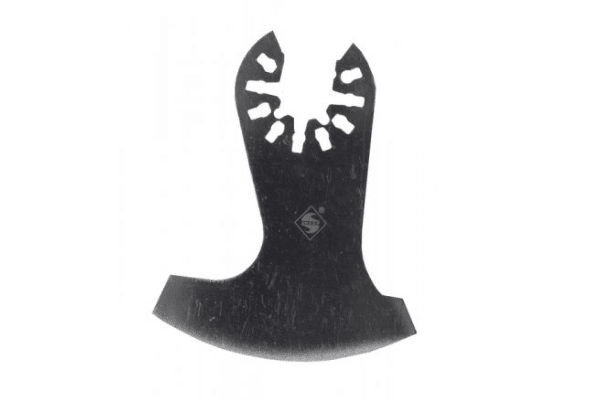
Adhesive/Grout Scraper Blade – By Артём В. – Own work, CC BY-SA 4.0
Project Specific Oscillating Tool Attachments
There’s an absolute cornucopia of multitool accessories that are designed for specific jobs and applications. In many cases, a standard plunge or segmented cutter could do the job equally creditably — with some cynical pros of the opinion that single-project focused attachments are nothing but a clever marketing ploy. However, if you would prefer a tool that’s theoretically created for a solitary job — you can also purchase:
- Tile removers.
- Grout removers.
- Adhesive removers.
- Concrete chipping.
- Nail shearing.
- Staple removal.
Starlock
Not types of oscillating multi tool blades, but instead a connecting system. Invented in 2016 by the power tool behemoths Fein and Bosch, its a novel fitting design that promises increased power transfer from the multitool motor to the blade head. What’s more, these clever guys color-code these attachments — with each hue indicating its suitability for particular applications. As a patented system, at the moment only these two innovative manufacturers offer Starlock machines — although third-party suppliers are allowed to retail Starlock compatible heads. Apparently, it’s something to do with licensing agreements. I don’t know the details, I’m an enthusiastic DIYer, not an armchair corporate intellectual property lawyer.
Conclusion
Oscillating MultiTool FAQs
Q: What Is The Best Metal Cutting Blade for Oscillating Tool?
For trimming and shaping, opt for a segmented blade. In order to penetrate areas away from edges, go for a plunge cut blade. Additionally, consider investing in a carbide-tip accessory to deal with the stubbornest of metals.Q: Can You Use an Oscillating Tool to Cut Metal?
Yes! Oscillating multi tools are ideal for cutting metal pipes, car bodywork, and stock sheeting — with the correct attachment. Check out my in-depth guide to multitool metal shearing and shaping.
Q: Are Fein Blades Good?
Yes! Fein is a reputable manufacturer of multitools and multitool accessories. Its blades are renowned for their durability, quality, and keen edge. A word of warning though. Fein utilizes the Starlock attachment system, hence its blades will only fit Bosch and its own machines.Q: Can Oscillating Multitools Cut Timber?
Indeed they can! Oscillating multitools are ideal for trimming baseboards, fitting doors, and shaping timber moldings — together with a segmented cutting blade. To discover the best ways to cut wood with your multitool, check out my article here.
Q: What Uses Are There For Multitool Blades?
Oscillating multi tools offer the DIYer and trade pro the ultimate in versatility through their interchangeable heads. They’re suitable for addressing metals, acrylics, plastics, and wood — while also permitting sanding, cutting, edging, honing, and shaping.
To discover the plethora of uses of these flexible machines, check out my guide.










